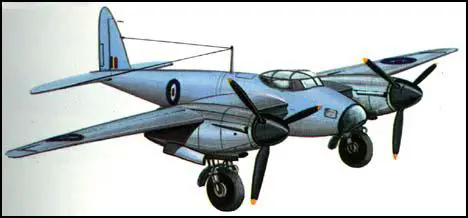Mosquito Mk I
In 1938 the De Havilland Aircraft Company began work on developing a reconnaissance bomber that would rely on speed to escape from the enemy. The project was accepted by the Royal Air Force in 1939 and the Mosquito Mk I. made its first flight on 25th November, 1940.
Powered by two Rolls-Royce Merlin engines, it had a maximum speed of 380 mph (611 km) and had a range of 2,180 miles (3,500 km). It was 40 ft 6 in (12.34 m) long with a wingspan of 54 ft 2 in (16.51 m).
On its first flight over France on 20th September, 1941, the Mosquito Mk I was challenged by three Messerschmitt Bf109 at 23,000 ft (7,010 m). It easily outflew the Germans and convinced the Royal Air Force that it had an outstanding reconnaissance aircraft.
Other versions included the Mosquito Mk IV bomber and the Mosquito Mk II night fighter, that both appeared in the summer of 1942. The Mosquito Mk IX bomber entered service in the spring of 1943. The Mosquito Mk XVI which went into action in late 1943 and had a pressurized cabin so it could reach an altitude of 40,000 ft (12,191 m).
One of the most successful of these aircraft was the fighter bomber Mosquito Mk VI. On 18th February 1944, the Mk VI was involved in the attack on the prison at Amiens that helped a group of French Partisans to escape from the Milice. They were also used for two bombing raids on Gestapo headquarters at the Hague (11th April, 1944) and Copenhagen (2nd March 1945). During the last months of the war the Mk VI made several bold low-level raids into Nazi Germany.

Primary Sources
(1) After the war Donald Bennett wrote about the Mosquito aircraft.
I test-flew the Mosquito by day and by night, and we got on with the 'test installation' of the Oboe equipment. At a meeting at the Air Ministry on the subject. Bomber Command and the Air Ministry both
very strongly opposed the adoption of the Mosquito. They argued that it was a frail wood machine totally unsuitable for Service conditions, that it would be shot down because of its absence of gun turrets, and that in any case it was far too small to carry the equipment and an adequate Pathfinder crew. I dealt with each one of these points in turn, but finally they played their ace. They declared that the Mosquito had been tested thoroughly by the appropriate establishments and found quite unsuitable, and indeed impossible to fly at night. At this I raised an eyebrow, and said that I was very sorry to hear that it was quite impossible to fly it by night, as I had been doing so regularly during the past week and had found nothing wrong. There was a deathly silence. I got my Mosquitoes.
Thus it was that the greatest little aircraft ever built came into the squadron service as a bomber in the Royal Air Force. From that decision grew many other things, not only for the Oboe squadrons but also for the general improvement of our bombing policy.
(2) George Orwell, BBC radio broadcast (10th October 1942)
British bombing raids on Germany continue. Now that the nights are longer the bombers can go further east, and several parts of the Baltic Sea have been bombed during the past week or two. More and more American planes are now taking part in the RAF raids. Yesterday, the biggest daylight raid of the war was carried out over northern France. About 600 Allied planes took part and only four failed to return. This day be compared with the biggest daylight raid carried out by the Germans, on September 15th, 1940, when 500 or 600 German planes came over Britain and 185 were shot down.
There have also been successful raids on German bases in occupied Norway. In these raids a new British light bomber, the Mosquito, has played a conspicuous part. The full details of the Mosquito have not yet been released for publication, but it is evident that it is a very light and very fast bombing plane, especially suited to daylight raids. We shall probably be able to give further particulars about it later.
